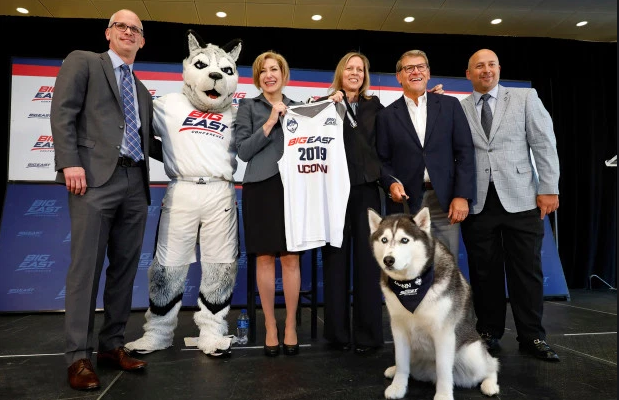- Attacking style not the only reason some Tottenham fans will back Ange Postecoglou until the bitter endPosted 5 months ago
- Paris Olympics takeaways: What did Team USA’s crunch-time lineup say about NBA’s hierarchy?Posted 10 months ago
- Zach Edey posted an easy double-double in Summer League debut. Here’s why he’ll succeed in NBAPosted 11 months ago
- What will we most remember these champion Boston Celtics for?Posted 12 months ago
- After long, seven-year road filled with excruciating losses, Celtics’ coast to NBA title felt ‘surreal’Posted 12 months ago
- South Florida men’s basketball is on an unbelievable heater– but also still on the bubblePosted 1 year ago
- Kobe Bufkin is balling out for Atlanta Hawks’ G League team. When will he be called up to NBA?Posted 1 year ago
- Former Knicks guards Immanuel Quickley, RJ Barrett may yet prove Raptors won the OG Anunoby tradePosted 1 year ago
- Rebounding savant Oscar Tshiebwe finally gets NBA chance he’s deserved for yearsPosted 1 year ago
- Is Tyrese Maxey vs. Tyrese Haliburton the next great NBA guard rivalry?Posted 2 years ago
Is UConn taking financial risk in moving to Big East?
- Updated: August 10, 2019
The year did not start well for University of Connecticut athletics in financial terms. On Jan. 17, 2019, an NCAA statement revealed that UConn reported the amount of revenue generated from sports in 2018 was $40.4 million, as opposed to expenses of $80.9 million (Associated Press).
That computes to a loss of $40.5 million in just one year. It would have been much higher had $8.5 million not been appropriated from student fees plus $30 million in institutional support.
Basketball caused a big chunk of the deficit
Although football drained the most money, men’s basketball lost $8.7 million and women’s hoops, the past several years the school’s most successful sports program, showed a deficit of over $3 million in 2018.
Those are significant numbers, especially for an institution that has recently committed to paying hefty sums to leave the American Athletic Conference and move into the Big East starting with the 2020-2021 academic year.
The original Big East, in which UConn was a charter member, is not the same legal entity as it is today. But the hope in Storrs, CT, is that the current Big East will bring back some of the old glamour for the Huskies with home and away games against traditional rivals Providence, St. John’s, Villanova, Seton Hall, and Georgetown.
Is it worth it?
While the coming switch in leagues is a done deal, UConn must still cope with a high price tag. And face that $40.5 million deficit as well.
There is normally a requirement to pay $10 million and give a 27-month notice to pull out of the ACC. But because the school believes it needs to happen earlier, it negotiated to pay $7 million more, or a total of $17 million, and reduce the time it can “escape” from the ACC. On top of that, there is still the Big East entry fee of $3.5 million.
A political issue
With all this in mind, it was probably no surprise that Leonard Fasano, the Connecticut Senate Minority Leader, in a letter to new UConn president Thomas C. Katsouleas dated August 1st, the very day he took office, urged that no student funds or taxpayer dollars be used for these moves. He says the costs should be borne by private donors, such as through the UConn Foundation, the official fundraising arm of the university, and from sources such as athletics, dining, housing and parking.
Fasano wrote: “If you have extra money in this non-academic revenue fund, it begs the question: are we overcharging students for these expenses? And if additional money exists, why does UConn continue to ask the state for more taxpayer funding year after year to cover growing expenses such as fringe benefit costs?”
The same day as the letter was received, Katsouleas spoke to Sen. Fasano by telephone and explained that 99% of the donations made to the UConn Foundation cannot, by law, be used for any other than their intended purpose, according to Stephanie Reitz, a UConn a spokeswoman.
Money could be saved
The school’s move to the Big East, announced in June, is designed not only to renew its old rivalries but to cut down costly road trips to states such as Oklahoma, Florida and Texas for conference games.
But since the Big East does not sponsor football or hockey, those sports are not even included in the move to that conference. UConn hockey remains a member of Hockey East, and the football program will operate as an independent.
Fasano says students should not pay the costs
In his letter, which was also sent to athletic director David Benedict and posted online, Sen. Fasano said that the ACC exit fee could also be subsidized by UConn athletics, non-degree programs, housing, dining, parking, and real estate income.
He wants assurance that the cost will not come from higher student fees. “I believe,” he wrote, that it would be most appropriate to pay for UConn’s exit and entrance fee using funds from the UConn Foundation,” which is the school’s fundraising arm.
Controversy over tolls
It is no secret that Connecticut, as a state, is not in the best of financial shape. Its governor, a Democrat, has been pushing for tolls on the highways to cover road and bridge maintenance, and so far, what looked like a slam dunk, has been put on hold. It is now a contentious political issue. Most Republicans in the legislature are opposed to tolls and no immediate resolution is in sight, nor does there seem to be a viable alternative.
Meanwhile, there are no tolls yet, while highways are in need of repair, bridges have to be kept safe, and the state is looking for the wherewithal to meet those needs. The general non-sports orientated public may be wondering how the state university or its foundation can justify spending millions of dollars to change conferences while the sports programs are already in the hole for $40 million.
In its defense, the university claims it will save $2 million a year in travel expenses by switching leagues. If that amount would be used to pay off the $40 million-plus deficit, it would take at least 20 years to do so, assuming the average doesn’t go any higher.
Two pointed questions posed by Sen. Fasano
The new UConn President is faced with these two tough questions posed by Sen. Fasano:
1) If there is extra money in this non-academic revenue fund, are we overcharging students for these expenses?
2) If additional money exists, why does UConn continue to ask the state for more taxpayer funding year after year to cover growing expenses?
Fasano also charged that “The UConn Foundation has previously paid for a variety of expenses … such as extremely expensive guest speakers, trips for the former governor and homes for UConn presidents … Money that students pay to UConn, whether it be for tuition, meals, housing or any other service, should not be misdirected. The UConn Foundation is a far more appropriate source to cover the costs of the Big East transition.”
The ball is in Pres. Katsouleas’ court
Borrowing from tennis, the ball is now in his court. This is a tough way for Thomas C. Katsouleas to start his tenure as the President of the University of Connecticut. And the formal inauguration will not even take place until Oct. 4th.




